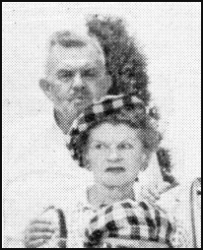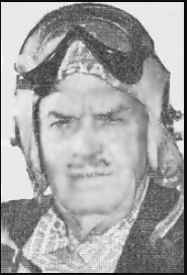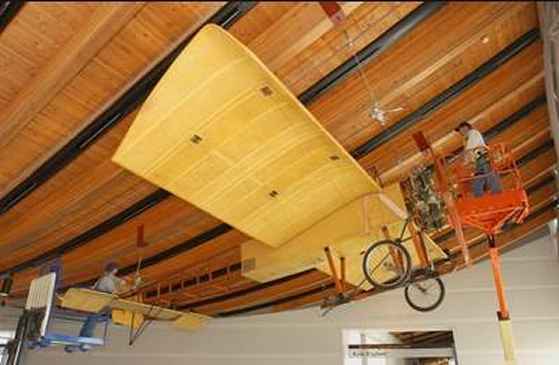

1896-1965 |
 |
 |
Philadelphia, PA., 1958 CHIRP, No. 60 |
Collection of Carl Whittle, 2-19-06 |
via email from Bill Halpain, 5-23-05 According to Bob Burke's book "From Oklahoma to Eternity, The Life of Wiley Post", Wiley joined Burrell Tibb's traveling "barnstormer" air show as a parachute jumper in the mid 1920's. He was with the show for several months during which time the show pilots, including Burrell, gave him flight lessons, thus beginning Wiley's aviation career. Burrell and Wiley remained friends and flew together on numerous occasions thereafter. He was also a friend of and pilot for Keith Kahle, the founder of Central Airlines. My connection with Burrell Tibbs is that he was my first flight instructor at Westheimer Field in Norman, Oklahoma. He soloed me in a J-3 Cub on April 14, 1956. I grew up in the small southern Oklahoma town of Sulphur and found that Burrell's sister lived on a farm not far outside Sulphur and he flew in and landed in her pasture often to visit. I knew his nephew who also lived in Sulphur. In 1959, Burrell was instructing at Downtown Airpark in Oklahoma City. I took a check ride with him in a Cessna 140 during that time. The last time I remember seeing him was in Oklahoma City in 1963. In asking the "old timers" around OKC about him, I found that he had done just about everything that could have been done in aviation, from flying around South America prospecting for uranium to flying whiskey into then dry Oklahoma. He began his aviation career during WWI, but I do not know exactly when. When I was his student, he had in excess of 35,000 hours flight time. He was QB #14336 in the Oklahoma City Hangar and is listed as having Gone West on May 5, 1965. The Oklahoma Historical Museum has a collection of some of his papers and hopefully, log books. I plan to make an appointment with the museum to review the collection in the near future. I will let you know if I find anything significant. Bill Halpain Bethany, Oklahoma |
via email from Carl Whittle, 11-27-05 I happened upon your website while surfing and was delighted to find my old flight instructor, Burrell Tibbs, listed as well as the note from Bill Halpain whom I know. Burrell was instructing out of Downtown Airpark (now closed) in Oklahoma City. He soloed me in a Cessna 150 at Max Westheimer Field in Norman, Oklahoma on September 7, 1960. It is an honor to have his signature in my logbook. My father accompanied me to the airport and, nearing his sixtieth birthday, asked Burrell if he thought he was too old to learn to fly, "I can teach a wooden Indian to fly", was his reply. Thus my father began his flight training. Thanks for the memories.... Carl Whittle Norman, Oklahoma |
via email from Carl Whittle, 2-19-06 Although I've known Bill Halpain (who was also a student of Burrell's) for many years, I did not know that we shared that famous instructor. I had the pleasure of having dinner with Bill a few nights ago at the Oklahoma City QB Hangar meeting where we talked about our old flight instructor and your website. Thanks for bringing us back together. |
 |
|
You asked if I had a copy of Burrell's signature. Attached is a scan of my logbook dated September
2, 3,4,5 and 7, 1960 with Burrell's endorsement. My first solo was on September 7. Note the serial number of his Flight Instructor
Certificate 2023!!!! You asked if I had a picture. See the attached (front and back) clipping from the Oklahoma City newspaper. Unfortunately, I didn't save the whole page and don't know the date. Perhaps you do. I mentioned Burrell telling my father, who learned to fly in his sixties, that "I can teach a wooden Indian to fly". A couple more of his wise sayings come to mind: "Many an air race was won by elbow grease the night before" which referred to the importance of keeping a plane clean & well polished as well as in good mechanical condition. Another was, "there has never been an (aircraft) accident without prior warning". I've found that to be true, but it depends heavily on hindsight, which is much sharper than foresight. He once told my father that in the military, he was the instructor of last resort for his training unit. When a flight school student had exhausted every recourse, he was sent to Burrell for salvaging before being washed out. Burrell said that most could be saved because he found that "they had never been taught to fly straight and level". As you probably know, most instructors spend about 10 minutes (if that) on straight and level flight before introducing more complex maneuvers. I flew with Burrell late in his life. He had a bad case of emphysema with difficulty breathing. On a flight from OKC to Norman, Max Westheimer Field (about 20 miles) he lay against the right door of the Cessna 150, apparently sound asleep and snoring. He could still instruct in his sleep however, because, without so much as opening an eye, he grumbled "get your damned foot off that right rudder". I was impressed. As I may have mentioned, the Air Space Museum in Oklahoma City has (or used to have) a large amount of information about and photos of Burrell. I say "used to have" because they have undergone a reorganization, of sorts, so I don't know the current status. You might contact them, or if you're ever out this way, stop by for some fascinating research. Best wishes, Carl Whittle Norman, Oklahoma |
via email from Tom Renger, 8-16-06 Thank you for your information on Burrell Tibbs. During 1955, while attending the University of Oklahoma, I joined the "Eagle Chaser's Flying Club." He was known as Burrell to me and was my flight instructor as he was THE flight instructor for the club and gave lessons from North Field, which is located just north of Norman, Oklahoma. There were two airfields during WWII, one known as South Field and the other known as North Field near Norman, Oklahoma and the hometown of the University of Oklahoma. I recall that Burrell showed me a full sized replica of Cessna's first fuselage. It was in the assembly stage of the wood, wire and treated linen cloth construction. He had blueprints of the original design and said that this aircraft was to be displayed In the lobby of Cessna's home office. I left the Un. of Oklahoma for Un. of Southern California before the project was finished. Do you happen to know what happened to this project? During one of my early instructional flights, Burrell suggested that I look out the left window as I was in the left seat and while looking down, Burrell shut off the engine. Burrell seemed to enjoy keeping his students alert. I immediately showed some concern and Burrell asked, "Well, what the hell are you going to do?" He waited a little time and then indicated that it would be a good idea to look for a place to land. We continued to sail toward the ground in our old Taylorcraft. Finally, Burrell feathered the prop and turned on the switch and the engine started immediately and we were on our way again. On another occasion, we were flying along and Burrell acted like he was sleeping, I think. He awoke and asked me, "Did you hear that clicking sound"? At first I didn't and then there was a random clicking sound. He again asked me what I was going to do about it? Having had the previous experience, my answer was to look for a place to land. Some time later, I caught him tapping the seatbelt metal end against the metal door jamb located on his hidden side. Burrell also indicate that he had flown numerous flights in a "Super Cub" searching for uranium deposits in Utah. Tom Renger |
via email from Don Williams, 5-20-11 I took some lessons from him while I worked at Downtown Airpark when I was in High School. Had to have been around 1948-49. I am looking for my logbook, still packed after returning to Oklahoma in 2007 after living in California since going into the Navy in 1954 when I graduated from O.U. Most of my flight time was with Cal Appleby and most of the flight training was in J-3 Cubs owned by Beverly's Flying Service. My post mentions the first Aero Commander. It's since been moved from the OKC fairgrounds to another city, not sure where at the moment.. I do have, however, a picture of it taken by a friend. I can send it if I find it on the other computer. I sure remember that publicity flight and pumping gas for that old prototype. As I recall, they didn't have funds to buy a reverse gearbox so both props turned the same direction, clockwise from the cockpit view.. Aero Commander 500 family Bob Hoover in his Aero Commander Shrike That movie about Hoover reminds me of the many times I saw him fly that dead-stick flight routine. One more comment- Downtown Airpark is no longer active. Closed to become condos by the river. One building remains, the one used to overhaul old Commanders. Don Williams |
|
THE BURRELL TIBBS COLLECTION Biographical Information* |
|
Born: Died: Aviation Background: |
Royce City, Texas, March 11, 1896 Oklahoma City, Oklahoma, May 5, 1965 |
|
1909 1912 1913 1914 1915-17 1917-19 1919 1922-29 1929-39 1939-41 1942-45 1946-50/51 1952 1953 1954 1957 Honors: Civic Activities: |
Exposed to aviation at dirigible races, St. Louis Exposition; later saw Glenn Curtiss fly, first paid exhibit, St. Louis. Worked during vacation as greaseball mechanic for the French Aviator Tom Benoist, builder of seaplanes. Apprentice to Tom Benoist in St. Louis (photographed in Harper's Aircraft Book, fig. 5, p. 132 beside Benoist plane). Went to the Curtiss School in Hammondsport and came back with new ideas for Benoist. Worked for Lester Miller in Dallas. January 9 soloed in Dallas; wrecked on second half of first solo. Barnstormer of the spectacular type in Oklahoma and Texas with Les Miller as an associate became Fixed Base Operators in East Dallas, Texas (Miller-Tibbs training camp business in Marlin, Texas). Flew in the United States with the Army Air Corp in World War I and trained wartime fliers. Became a member of "Texas Top-Notch Fliers," barnstormers. Conducted commercial air service and flying school at Municipal airport in Oklahoma City. Performed as a barnstormer and flew Mexico to United States route. Operated a CPT (College Pilot Training) School in Oklahoma. Pilot instructor during World War II Sold war surplus and new aircraft while instructing in a GI training school. Employed at Boeing in Wichita. Operated a flying service at Grand Prairie, Texas. At age 57, flew a World War I Jenny from Bloomington, Illinois to Grand Prairie, Texas, a seven day trip covering 750 miles, to celebrate 50th anniversary of powered flight. Constructed Silver Wings, a replica of Clyde Cessna's 1911 airplane. Served as Public Relations assistant to the manager of Oklahoma City's Downtown Air Park. Taught cadet aviation at the University of Oklahoma, Norman. April 14, 1929 "Burrell Tibbs Day, Honoring Oklahoma's Pioneer Flier," statewide celebration designated by licensed pilot of Oklahoma. May 25, 1929 Oklahoma Chamber of Commerce presented an official award for his services in the advancement of commercial aviation in Oklahoma and the United States. Director of Aerosphere Show, Oklahoma Semi-Centennial. Member: Early Birds, OX5 Club of Aviation Pioneers, Q.B. Club of Oklahoma and Texas, Air Indians, Antique Aircraft Association, Tau Omega (honorary), Kill Devil Hill Memorial Society, Institute of Aeronautical Science, Experimental Aircraft Association. Member of First Christian Church in Oklahoma City. |
|
* Discrepancies in Dates; see biographical file. Editor's Note: This timeline was transcribed and submitted by Bill Halpain, to whom we are very grateful. |
 CLYDE CESSNA'S SILVER WINGS On Display at Exploration Place in Wichita. |
SILVER WINGS ON DISPLAY
Dear Mr. Cooper:email from C. Edward Young, 2-20-12 Several of the participants in the Burrell Tibbs recollection page asked about the ultimate destination of the Silverwings Project Mr. Tibbs’ completed for Cessna. While I cannot be certain it is the aircraft, in 2003, Cessna loaned a Silverwings Replica to Exploration Place in Wichita. If it is the aircraft, this is an excellent opportunity to see a continuing part of Mr. Tibbs’ legacy that touched so many pilots. Even if it is not the aircraft, Exploration Place is an amazing place for aviation mind folks to explore, particularly with the next generation of pilots. Regards, C. Edward Young Director of Aviation, Kansas Editor's Note: You can read the full article by clicking on the link. |
SILVER WINGS BACK HOME
Hello Mr. Young and Mr. Cooper,email from Deborah Dimmick, 3-13-12 Exploration Place had a contract with Cessna Aircraft Corporation to display the Silverwing for the 100th anniversary of powered flight in 2003. The contract was to run from March 2003 to January 2005 but remained here until 2010. The Silverwing is now once again with Cessna Aircraft Corporation. If you want to contact Cessna I would begin with Rhonda Fullerton, Director of Marketing Operations. Her email is rfullerton@cessna.textron.com. If there is anything else I can help with please do not hesitate to let me know. Deborah Dimmick Project Manager/Artist Exploration Place 300 N. McLean Blvd. Wichita, KS 67203 316-660-0610 ddimmick@exploration.org |
Collection of Carl Whittle, 2-19-06 Tibbs -- his little-known first name was Charles -- was the man who taught Wiley Post to fly. He crashed on his solo flight in 1915 and two years later he began training World War I army pilots. In 1919, he left the army and 650 Tibbs-trained pilots. In 1929, the Oklahoma State Chamber of Commerce organized a "Burrell Tibbs Day". The outstanding commercial pilot of the southwest was honored at 63 airports throughout the state. He was one of the few men professionally engaged in commercial aviation before 1916. Others who made a business of flying those days were such men as Orville Wright, Glenn Curtiss, Glenn L. Martin, Clyde Cessna and Chance Vought. Flying began for Tibbs in 1909 when a barnstorming Frenchman threw a tightly wound ball of mechanic's tape at the Marion, Ill., youth for getting too close to the plane. Until 1915, when he was 17, actual flying was deferred, but Tibbs stayed close by being a choreboy and mechanic for aviation firms. His chance to fly an old pusherplane came in 1915. He once estimated the distance traveled forward as about 100 feet and his top altitude at 150 feet. The next flight was more successful. After the war he barnstormed once again. He came to Oklahoma City in 1924. His first job was with The Daily Oklahoman flying papers, milk, bread, medicine and other priority goods during a flood that raged for nearly two weeks. A flying circus came next, but not for long, for in 1925 Tibbs bought a field at SW 29 near Grand. He operated the field until the city built its own airport nearly across the street. He became the city's first airport manager. Tibbs went broke in the depression. He flew for western movie star, Jack Hoxie, took another fling at running a flying service, tried developing an airplane powered by a Ford engine, did crop dusting and then came another war. The pilot instructor of World War I returned to the same job for the army in World War II. After the war he managed several airports in Oklahoma and Texas and returned to Oklahoma City about 1948. He was elected president in 1963 of the Air Indians, a chapter of the Antique Aircraft Association, a national organization. Services will be at 10 a.m. Friday in First Christian Church. His body will be cremated and the ashes dropped from an airplane above his birthplace, Royse City, Texas. Watts Funeral Home is in charge. Survivors include his wife, Julia; two daughters, Mrs. Ruth Crossley and Mrs. Jeanne Santerre, both of 1215 Military Ct., and a son, Charles B., with the air force. |
|
If you have any more information on this Early Bird, please contact me. E-mail to Ralph Cooper Back 

|